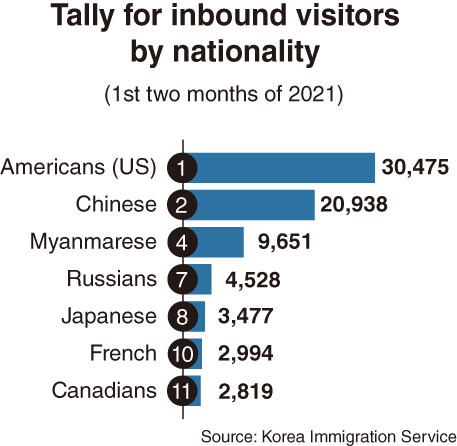 |
Travelers participate in an event hosted by the Korea Tourism Organization at Seomun Market in Daegu in 2015. (KTO) |
SEJONG – Chinese travelers were the largest group of foreign visitors to South Korea by nationality before the COVID-19 pandemic hit.
But state data shows that the rankings in foreign visitor numbers have changed in recent months: The US accounted for the largest portion of inbound visitors among foreign nationals.
According to the Korea Immigration Service, the number of inbound travelers from China was 20,938 (including 6,095 ethnic Koreans residing in China) during the January-February period of this year. This marked a 96.7 percent decline from 626,170, tallied during the corresponding period in 2020.
In contrast, the number of visitors from the US reached 30,475 from January-February of this year, outnumbering Chinese visitors by more than 9,500. In addition, the decrease in the number of US travelers stood at 75.8 percent on-year.
A research analyst estimated that the reversal could be attributable to the disparity in the number of COVID-19 infections in South Korea, China and the US.
 |
(Graphic by Kim Sun-young/The Korea Herald) |
The KIS data showed that the number of US nationals decreased sharply in the first quarter of 2020, when the number of infections grew rapidly in Korea. But the number of inbound visitors from America has gradually increased after the virus dealt a severe blow to the US, starting in the second quarter of 2020.
Likewise, an increase of Chinese visiting Korea was seen when the virus initially hit Wuhan in late 2019 and early 2020. But Chinese citizens started to stay at home after the number infections in Korea started growing faster than China in March and April 2020.
US nationals placed No. 4 in the tally for two consecutive years -- in 2018 and 2019 -- ranked below Chinese, Japanese and Taiwanese.
But, during the January-February period in 2021, the tally for inbound visitors from Japan and Taiwan plunged to 3,477 and 894, respectively.
Over the same two-month period, placing third on the list was visitors from the Philippines at 16,265, following the US and China. Among the next on the list were those from Myanmar (9,651), Indonesia (6,795), India (5,088) and Russia (4,528), Japan (3,477), Vietnam (3,113), France (2,994) and Canada (2,819).
Among noteworthy declines, the number of travelers from Hong Kong plunged by 99.8 percent -- from 86,045 to 208 on-year. Singapore posted a 98.8 percent decline from 16,731 to 194, and Australia with a 98 percent decline from 21,164 to 431.
Meanwhile, the number of foreigners staying in Korea -- both as long-term residents and short-term visitors -- has dropped to its lowest level, 2.01 million, in more than four years amid the pandemic.
According to the KIS, the tally of foreign nationals in the nation was 2.52 million in December 2019, 2.37 million in December 2018, 2.18 million in December 2017 and 2.05 million in December 2016.
The February 2021 figure marked a 20.2 percent decrease in only 14 months, meaning there were 510,000 fewer foreign nationals than the 2.52 million tallied at the end of 2019.
The drop was particularly notable among short-term visitors -- those with permission to stay in Korea for no more than 90 days. The figure declined 18.7 percent on-year to 427,930 in February 2021.
Over the same one-year period, the number of long-term visitors -- people staying 91 days or longer -- declined 9.3 percent, from 1.74 million to 1.58 million.
By Kim Yon-se (
kys@heraldcorp.com)






![[Exclusive] Hyundai Mobis eyes closer ties with BYD](http://res.heraldm.com/phpwas/restmb_idxmake.php?idx=644&simg=/content/image/2024/11/25/20241125050044_0.jpg)
![[Herald Review] 'Gangnam B-Side' combines social realism with masterful suspense, performance](http://res.heraldm.com/phpwas/restmb_idxmake.php?idx=644&simg=/content/image/2024/11/25/20241125050072_0.jpg)

